Everyone knows the Solar System, right? Sun at the center, followed by the four, rocky inner planets, the asteroid belt, the four outer gas giants with their moons, and then the Kuiper belt.
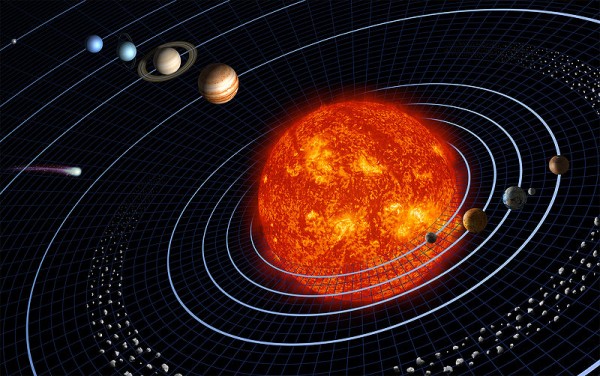
Sometimes Jupiter sends an asteroid headed our way, and sometimes Neptune sends a Kuiper belt object towards us. The ones Neptune sends us are the comets that we see, and the ones Jupiter sends us are asteroids. (Illustration not to scale.)
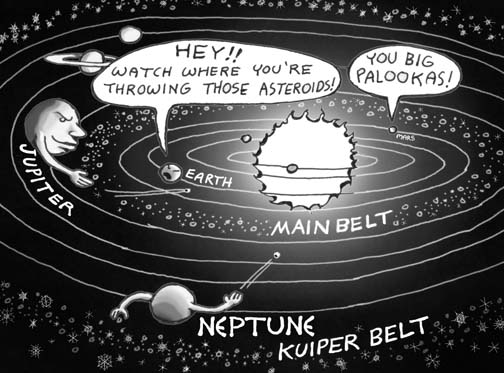
But many of these Kuiper belt objects are pretty large, such as Pluto and Eris, and there are a total of eight in particular of these trans-Neptunian objects that are particularly large.
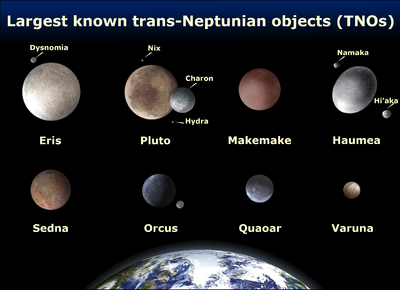
But, of the big ones (more than 1,000 km in size) which one is the closest? We have many candidates. Pluto was very close for a while, even closer than Neptune for a bit. Eris is farther right now, but will someday also slide inside of Neptune's orbit. Pluto is the brightest one in the sky, but Eris is the biggest and most massive of any we've discovered. So, enough already, which one is the closest?
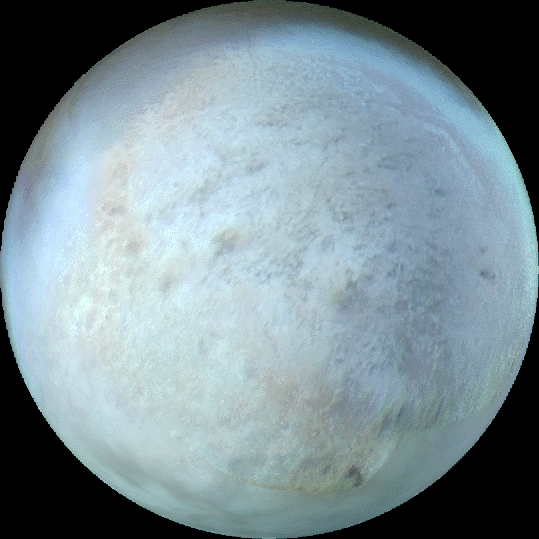
Trick question! Neptune's moon Triton is -- from all the evidence -- a captured Kuiper Belt object. At 2700 km in diameter, it is bigger than both Eris and Pluto, and appears to be more dense and massive than either of them as well. It has a thin atmosphere, and -- unlike every other moon in the solar system -- it revolves around its planet in the opposite direction from the planet's rotation.
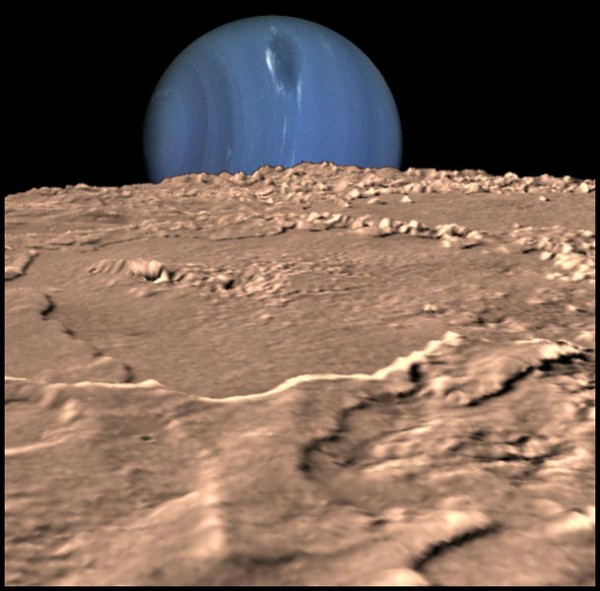
When Voyager 2 passed it in 1989, it took some fantastic pictures, including this composite mosaic which was constructed of its surface. As you can see, it's loaded with cracks and fissures, indicating some violence that took place there.
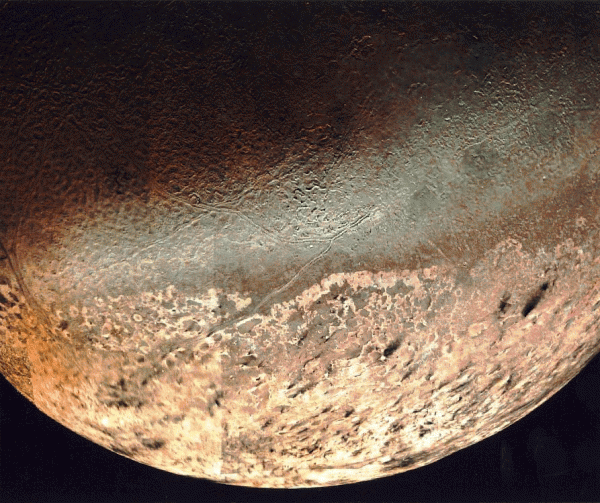
Of all the large moons in the Solar System, this is the only one that we think is entirely unrelated to the planet that it orbits. Imagine that: an object from beyond Neptune, bigger, brighter, and closer than all the others, was captured by the gas giant! So, that makes it the closest of all the large trans-Neptunian objects. I'm sorry for the trickery, but isn't that a neat bit of history about our Solar System?

We probably owe Jupiter some thanks for that, couldn't an object of that size wreak havoc if it got to the inner Solar System?
Cool story!
Well Triton was captured by Neptune. I don't think there's any evidence Jupiter had anything to do with the capture. In any case - yes, if a Triton-sized object hit something in the inner solar system, a lot of damage would be done, but in our solar system (quite unlike the obviously fictional solar system depicted above), the distances between planets are enormous compared to the sizes of the planets themselves. Thus - the chance that some object that comes flying into the inner solar system will hit something is very, very tiny. Generally such an object will just zoom by and head back out into the outer solar system..
Very cool. Thanks for sharing it with us. Could something like that happen again with a Triton-sized object? How difficult is it for the gas giants to pull in a new moon for themselves?
(Very wet behind the ears amateur astronomer here)
If we're talking CAPTURED KBOs, what about Phoebe, Saturn's approximately-160-km.-wide outermost "classical" moon? When the Cassini probe photographed it close-up in June 2004, prior to entering Saturn orbit, the consensus of the project scientists was that they were looking at a "refugee from the Kuiper Belt." Has that consensus changed?
Granted Phoebe is not Trans-Neptunian, but your headline reads "Closest KUIPER BELT OBJECT."
Paul,
Size matters. By that argument, I could say that Comet Holmes, still being closer than Saturn and clearly coming from the Kuiper Belt, is the closest Kuiper Belt Object. But I put an (admittedly arbitrary) cutoff that it has to be at least 1000 km in size to qualify. Triton is impressive; a 160 km moon? That's smaller than my Death Star!
You also forgot that you need the word "large" in this phrase: "unlike every other moon in the solar system -- it revolves around its planet in the opposite direction from the planet's rotation."
It's okay to have an arbitrary size cutoff, but surely you don't want to write stuff that's just wrong.
You've been blogging some amazing stuff lately. Please keep at it!
This article has been added to the Astronomy Link List.
Are these KBO's rocky objects (looks like that in the picture of triton)? If so, how come we have rocky inner planets, gaseous outer, and then again rocky KBOs? Until now I thought some form of density separation, but obviously not.
These large round Kuiper Belt Objects constitute a third class of planets, as they are in hydrostatic equilibrium, meaning they are large enough to have been pulled into a round shape by their own gravity. This distinguishes them from the majority of shapeless asteroids and KBOs. Our solar system has a third category of planets, the dwarf planets (which, in spite of the controversial IAU decision by four percent of its members, which was opposed by hundreds of professional astronomers led by Dr. Alan Stern, Principal Investigator of NASA's New Horizons mission to Pluto) in addition to the terrestrial planets and the gas giants. Please do not blindly accept the artificially narrow IAU view that our solar system has only eight planets, as this is just one interpretation in an ongoing debate.
Laurel,
Me? Blindly accept the narrow view that we have 8 planets, case closed? You must not have been reading me for very long.
Our solar system, as far as I'm concerned, has 5 different things of interest: the Sun, the inner, rocky planets, the asteroid belt, the gas giants, and the kuiper belt. Many asteroid belt and Kuiper belt objects are extremely interesting, and many moons are particularly interesting (Io, Europa, Titan, Triton, and the aptly-named "the Moon").
I think the big thing to learn from all of this is that regardless of what names you give to these things, the Solar System is much more interesting than just "a star with X planets."
Is Phoebe also thought to possibly be a captured kuiper belt object?
KBOs and the asteroid belt objects: the flotsam and jetsam of the solar system.
jetsam being the ones flung by Jupiter and Neptune and flotsam being the rest floating around.
Isn't Ceres thought to possibly have originated from the Kuiper Belt? Compared with Vesta, it seems icy and and undifferentiated, perhaps more like a comet than an asteroid.
To be sure, we needn't worry about it much now. We can wait for the Dawn mission to inform us, at which point we might have a much better idea as to its origins. Or if we don't, at least we'll know it's a real problem.
Glen D
http://tinyurl.com/6mb592
Very cool! For whatever reason, I had somehow missed out on the fact that Triton revolves around its planet in the opposite direction from the planet's rotation.
In response to Mu, no Triton is not rocky; there aren't any objects that aren't predominantly icy out beyond Saturn. There are lots of organic compounds floating around that can turn surfaces dark, especially after having been exposed to UV radiation for billions of years; comet surfaces tend to be black as coal.
As for planets, the majority of astronomers support the IAU definition (or something quite close to it, naturally there is disagreement). There were thousands of astronomers (including me) at the IAU, we hashed this out thoroughly, and there was very little support for the first suggestion of an IAU committee that Pluto, Ceres, Eris, and Charon should also be declared planets, along with anything "round". How should "round" be defined--how round is round enough? And do we really want to have dozens of objects floating around the solar system which might or might not be accorded "planetary" status depending on whether we can eventually prove they're round, to some degree or other? The IAU is the determining body for astronomical nomenclature, and thus the issue is, for the moment, settled--though I'm sure it'll be argued again in Rio this summer at the next IAU meeting.
Anyway, I'll agree with Ethan that the dwarf planets, moons, asteroids etc. are extremely interesting!
No, Craig, sorry, but the issue is NOT settled. You claim the majority of astronomers support the IAU decision but show no data to back that up. Furthermore, among planetary scientists, a much larger percentage oppose the decision, specifically, the statement that dwarf planets are not planets at all. The IAU is the "determining body for astronomical nomenclature" only if enough astronomers continue to consent to this. Many are now questioning whether there should be a separate body specializing in planetary science, as many planetary scientists are not IAU members.
424 IAU members out of 10,000 voted on this. No electronic voting was allowed. The IAU violated its own bylaws by introducing a resolution in real time without first vetting it by the appropriate committee as required.
What is wrong with having dozens of planets in the solar system? The objection solely to large numbers is not science; it is based on convenience. What is wrong with having multiple subclasses of planets. Roundness is key because it means an object is large enough to pull itself into a spherical shape by its own gravity, a state known as hydrostatic equilibrium. This is a characteristic of planets and not of shapeless asteroids and KBOs.
For all but the smallest bodies, determining whether they are in hydrostatic equilibrium is not an issue. And it is disingenuous to lump spherical objects more akin to planets than to asteroids into the same category as those asteroids. The IAU definition classifies objects solely by where they are while ignoring what they are. This is a serious problem. If Earth were in Pluto's orbit, according to the IAU definition, it would not be considered a planet either.
Regardless of what the IAU decides, if enough scientists reject its definitions and/or come up with better ones, the IAU may very well become irrelevant. Three years after the decision, it is just as controversial as ever. The IAU has failed to impose its decree and will continue to do so as long as enough professional planetary scientists reject their decision.
Hijacked The Triton moon pic for wanton Photoshop manipulation as seen here - Grandiose Presuposition - no interplanitary bodies were harmed in the production of this not for profit image.
---
the order of symbolic measures.
Its very interesting..(two thumbs up for that)
that's what I like for science..
New discoveries and facts.. but were not really sure coz some opinions were being fact and some other fact runs to an opinion.
but some other ways...
I like Astronomy.. even the branches of science...
that makes me 100% comfortable during our discussions in science. :)
I'll join NASA when I'm fully mature.. :)
thanks a lot
May I ask some questions regarding to the universe,its comes on my mind then I've ask for it..
out of your discussion for about that Kuiper belts and other dwarf planets... now were talking for about the universe...
Who was the first person to out about the Milky Way??
And does his/ her took some pictures of it and saw some crashes or some violent events over there?
Mayumi,
In an area with no artificial lighting it is very easy to see the Milky way. Ancient Greek Astronomers gave it that name (since it is a whitish streak in the sky). Many other societies observed it and called it different names. People didn't realize exactly what the Milky way actually was until Galileo made the first modern Telescope in the 1500s, and even then it took centuries before people were sure.
P.S.
Ethan,
I would just like to tell you that your profile pic is inspiring.
John,
I was just studying some recent pictures of Saturn's moon Titan. This moon seems quite unusual and is unlike any of Saturn's other moons. This made me wonder if it too could once have been a KBO? Does anyone know if its mass/density is similar to a KBO?